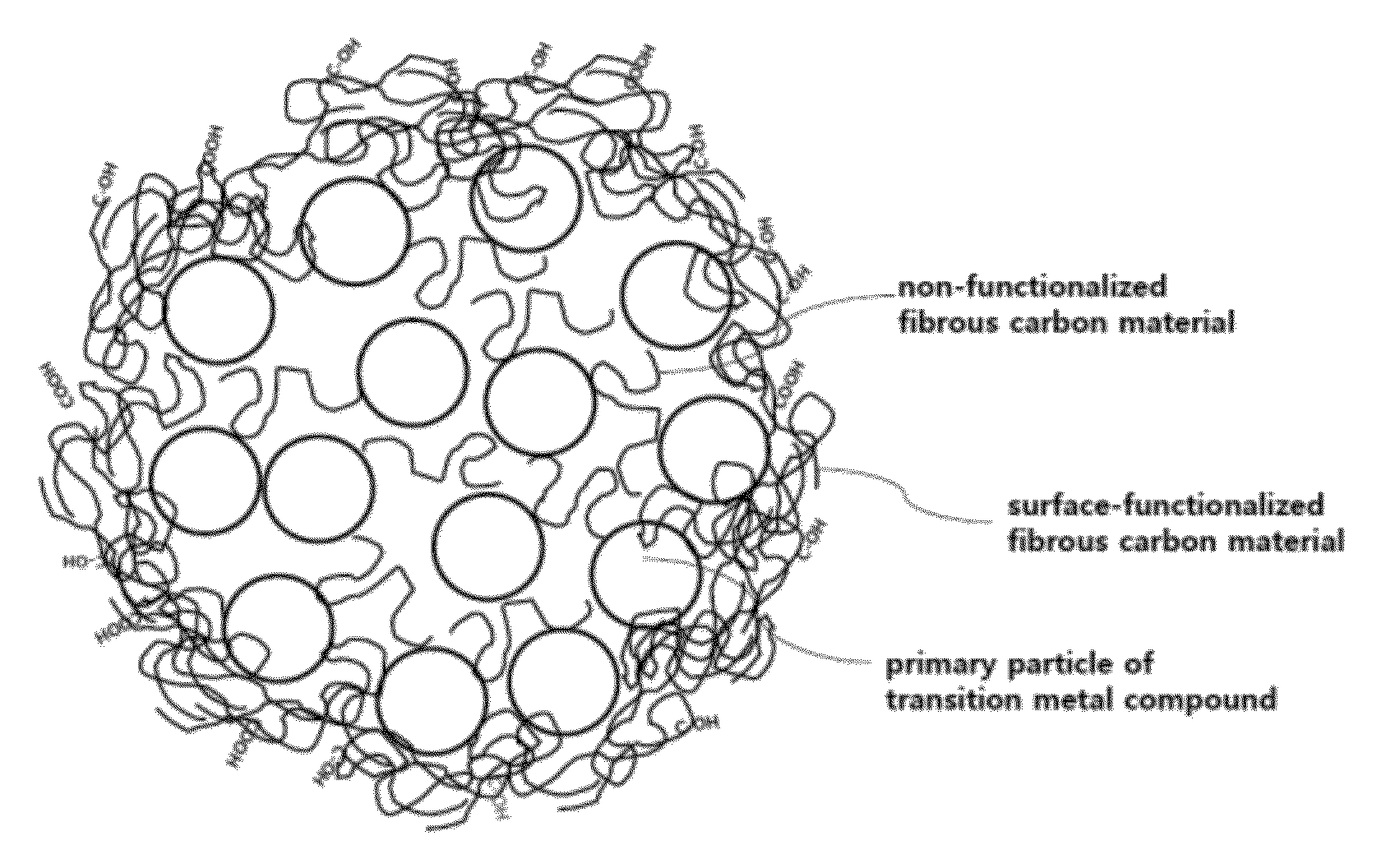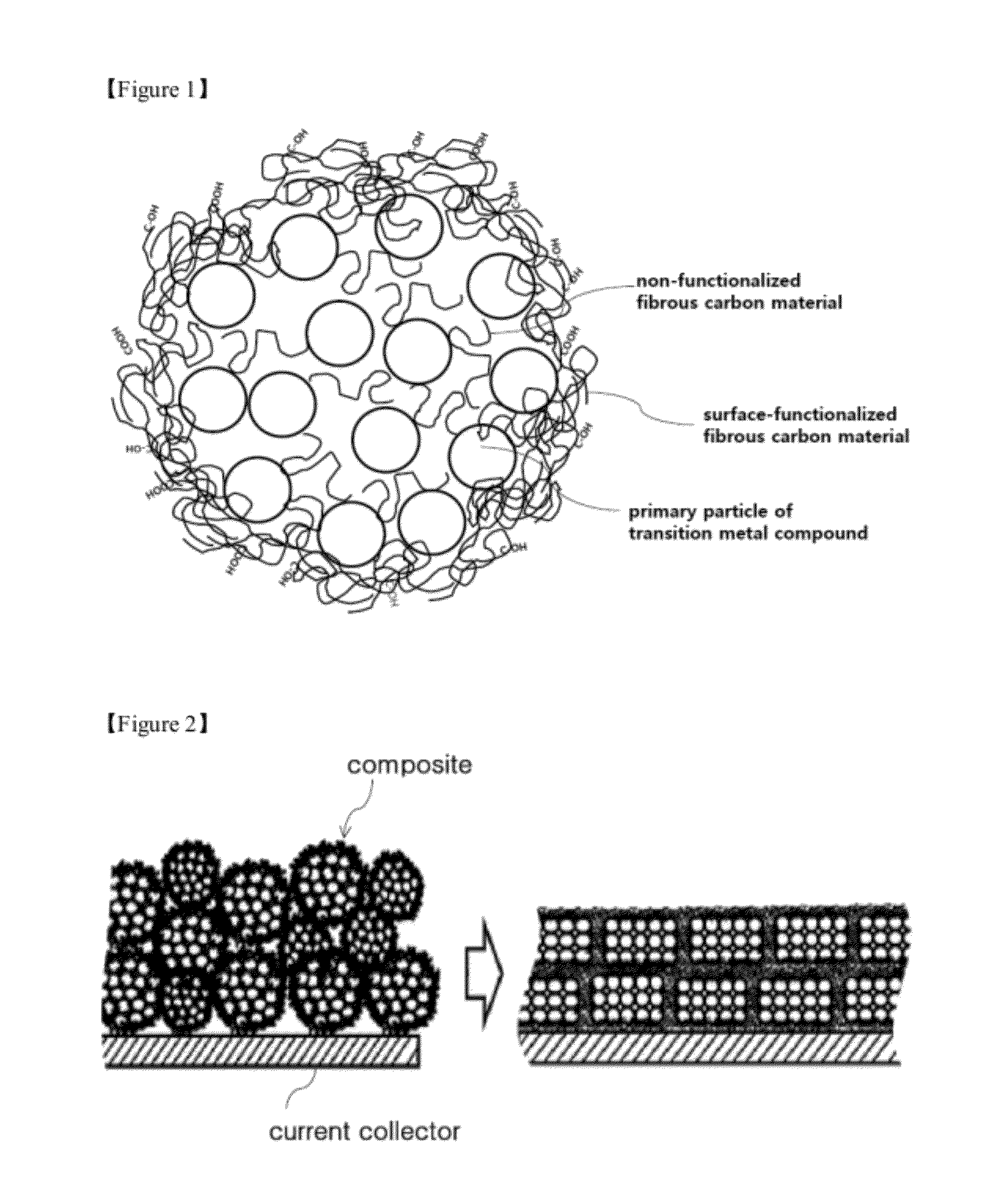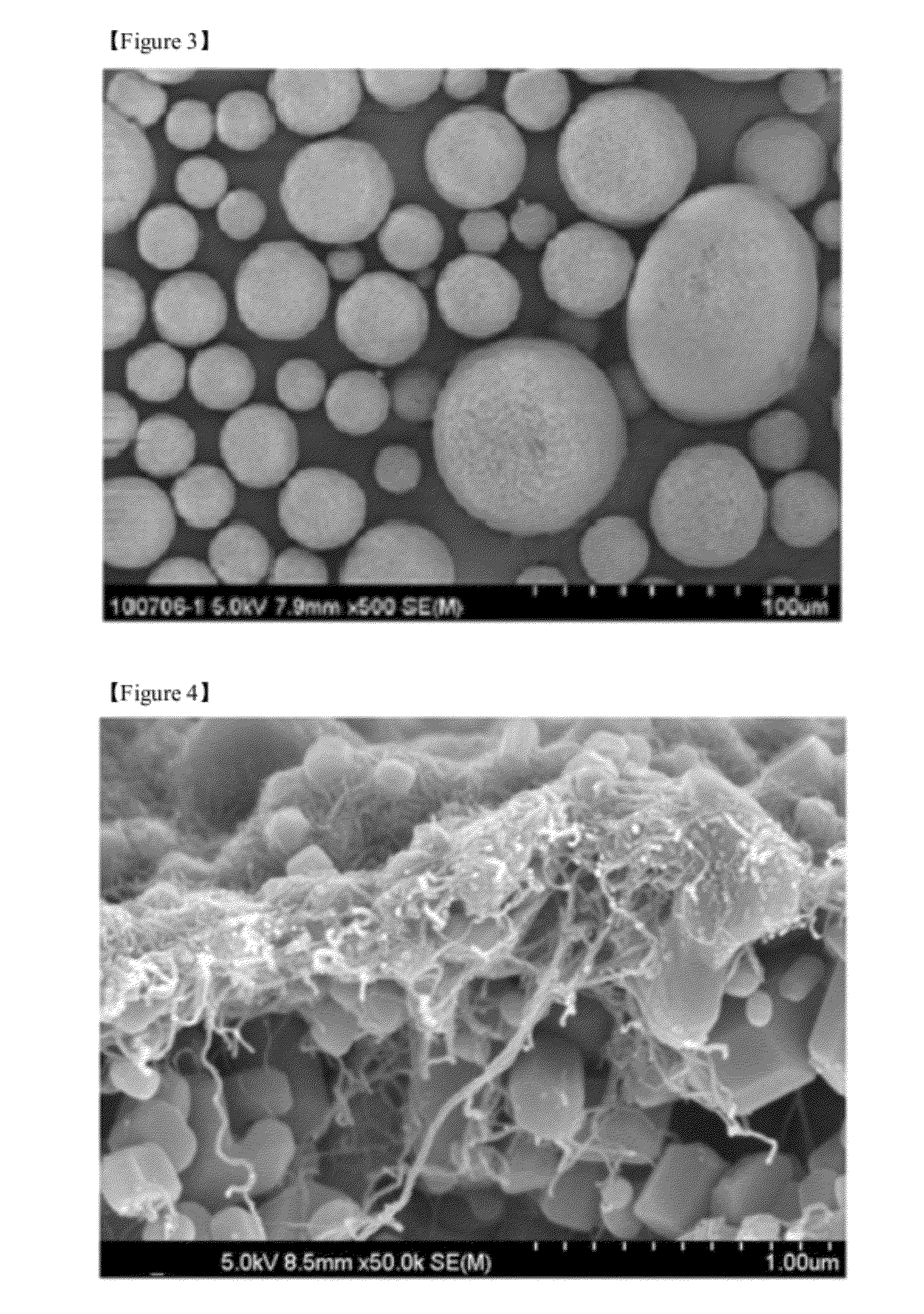Composite comprising an electrode-active transition metal compound and a fibrous carbon material, and a method for preparing the same
a transition metal compound and fibrous carbon technology, which is applied in the field of composites comprising an electrodeactive transition metal compound and a fibrous carbon material, can solve the problems of low dispersibility, decreased electrode density, and insufficient thickness of coatings, and achieves superior electric conductivity, increase the electric conductivity of the complex, and improve the effect of electric conductivity
- Summary
- Abstract
- Description
- Claims
- Application Information
AI Technical Summary
Benefits of technology
Problems solved by technology
Method used
Image
Examples
examples 1-10
Preparation of a Granular Complex of Lithium Iron Phosphate (LiFePO4)-Fibrous Carbon Materials
Step a) Preparation of Dispersions of Fibrous Carbon Materials
[0095]Surface-functionalized carbon nanotubes (CNTs) comprising 1.27 wt % of oxygen and 0.21 wt % of hydrogen, non-functionalized CNTs, dispersants made of styrene-acryl-based hydrophilic copolymers, and dispersants made of acryl-based hydrophobic polymers were introduced into distilled water in the ratios shown in the following Table 1, and mixed and dispersed with a homogenizer to produce five kinds of CNT dispersions having different mixing ratios of the surface-functionalized CNTs and the non-functionalized CNTs.
TABLE 1Quantity ofQuantity ofDispersantQuantityCNT Added (g)Added (g)ofNon-Surface-Styrene-Distilledfunc-func-acryl-WatertionalizedtionalizedbasedAcrylAddedClassCNTCNTcopolymerspolymer(g)Dispersion 10.329.723.760.24970Dispersion 21.528.522.81.2970Dispersion 33.027.021.62.4970Dispersion 44.525.520.43.6970Dispersion 56....
example 11
Preparation of a Complex Comprising LiMPO4 (M is a Combination of Fe, Mn, and Co) and Carbon Nanotubes
[0098]34.7 g of ferrous sulfate heptahydrate [FeSO4.7H2O], 36.3 g of nickel nitrate [Ni(NO3)2.6H2O], 43.7 g of manganese nitrate [Mn(NO3)2.6H2O], and 36.4 g of cobalt nitrate [Co(NO3)2.6H2O], and 48.95 g of phosphoric acid (H3PO4) were added to produce a first solution. 24 g of lithium hydroxide monohydrate (LiOH.H2O) and 200 mL of 28% ammonium hydroxide (NH4OH) solution were mixed, and 200 mL of distilled water was added thereto to produce a second solution.
[0099]The first solution was added to a reactor and, while stirring, the second solution was added thereto. Upon completion of the addition, the reactor was closed, heated, kept at a temperature of 180° C. for 4 hours, and then cooled to room temperature. The cooled mixture was removed from the reactor and washed three times with 500 mL of distilled water through a filter having a pore size of 0.2 μm. Upon completion of the wash...
example 12
Preparation of a Complex Comprising LiMPO4 (M is a Combination of Mn and Fe) Having an Olivine Structure, and Carbon Nanotubes
[0101]0.5 mol of manganese sulfate (MnSO4) and 0.5 mol of ferrous sulfate (FeSO4) as precursors of the metal M, 1 mol of phosphoric acid as a phosphoric acid compound, and 27.8 g of sugar as a reducing agent were dissolved in 1.6 L of water to prepare a first solution. 1.5 mol of ammonia as an alkalizing agent and 2 mol of lithium hydroxide as a lithium precursor were dissolved in 1.2 L of water to prepare a second solution.
[0102]The first solution and the second solution were processed in the order of the following steps (a), (b), and (c) by a continuous-type reaction apparatus to prepare lithium manganese iron phosphate.
[0103]A tubular, continuous-type reaction apparatus was used. The raw material solutions were mixed in a first mixer and then went through a second mixer in which distilled water of a high temperature was mixed therewith, went through a tubu...
PUM
| Property | Measurement | Unit |
|---|---|---|
| length | aaaaa | aaaaa |
| particle size | aaaaa | aaaaa |
| temperatures | aaaaa | aaaaa |
Abstract
Description
Claims
Application Information
 Login to View More
Login to View More - R&D
- Intellectual Property
- Life Sciences
- Materials
- Tech Scout
- Unparalleled Data Quality
- Higher Quality Content
- 60% Fewer Hallucinations
Browse by: Latest US Patents, China's latest patents, Technical Efficacy Thesaurus, Application Domain, Technology Topic, Popular Technical Reports.
© 2025 PatSnap. All rights reserved.Legal|Privacy policy|Modern Slavery Act Transparency Statement|Sitemap|About US| Contact US: help@patsnap.com



